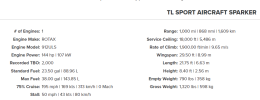I'm delighted with this NPRM and I think if it is codified as is that it will be a huge win for GA!
I don't see the "huge" in it. By LSAers' own admission, the demographic is small. LSA pilots are not even a plurality of the recreational demographic. Most people qualify for Basic Med, even in present handicapped circumstances.
I know some are disapointed that a path to move some of the legacy fleet into LSA wasn't included, but this really was never going to happen and was out of scope for MOSAIC.
And this is the only reason I'm replying in the first place. Someone was bound to go there, so here we go:
To the bolded: It's true it wasn't going to happen, but not for the reason you state. Don't rationalize what didn't get through in order to pitch one's newfound benefactor as good faith actors. Same rationalization from the LAMA people: "
oh, this was only about allowing LSAs into the photowork space". Yeah,
that "giant of industry" subsector was the reason the lines were long about MOSAIC debate, sure thing... *eyeroll* The goal-post shifting is epic.
The NPRM makes a larger portion of the GA fleet accessible to Sport Pilots and creates a path for middle aged aircraft owners like myself to age out of their aircraft.
Again, people who can't meet BasicMed are not inflection cases, nor will their participation "save GA", by volume. I got nothing against people who can't hold a third class, but they're not the plurality of the participants who patronize the recreational sector of aviation. Fiddling around the edges and calling it "huge" wins is precisely the 'elixir of incrementalism' that keeps the line items that are statistically
substantive (and thus deal with the controversial stuff the powers that be don't want to let go of), firmly ossified in place.
I see nothing about BasicMed that would preclude me from owning my aircraft going forward, LSA or not. The day I can't legitimately self-certify under BasicMed is the day I'd have no business getting in any flying contraption, LSAs very much included. So as a middle aged aircraft owner, I don't see this being a "middle age" relevant inflection.
I think the biggest win is that much more capable aircraft will be available as LSA.
No, that's called moot, without pricing context. It doesn't escape me in the least how that inconvenient line item has been largely whistled past in this thread, save by one poster who brought it up. Just like healthcare, "available vis affordable" sleight of hand.
Those that are mechanically inclined, don't mind maintaining their own aircraft, and are willing to obtain the proper certs will see their operating costs plummet.
No it won't, for the same reason as above. CAPEX. Six of mine, half a dozen of yours. Let me guess, you also believe the housing axiom that spending a dollar to save a quarter (mortgage deduction) saves you money.
The dynamics of the issue here are still affordability and control/discretion (which feedback loops to the former). If anything, this continues to cement the decline of the hobby, precisely because it doesn't tackle the regulatory burden for the airplanes that are actually affordable in the real world. A world where most can in fact hold a 3rd class medical, to say nothing of basicmed. But now the can gets kicked down the road another decade, because "
we gave you mosaic, now be quiet for a while". By my count they're going about a decade to the day, from the last so-called reform (part 23). If this is called winning, I wanna start losing for a bit.
Now, if the argument is that some hypothetical tsunami wave of Euro performance capable LSA will flood the production lines, creating a glut of used inventory to replace the current fac built
in 30 years, when the former are fully depreciated and thus people of median means can enter that market? Sure. But even if I were to stipulate that outcome (and I don't, for reasons I will not expand on for the sake of brevity), that means one of us will prob dead by then, and both certainly long past being in a position to shoehorn into a proverbial eurozone-compatible contraption in the first place.
And not that it matters, but I'm of the opinion the future is EAB, not SLSA. And the market will continue to shrink, and will be less democratic, independent of the strides EAB is making on keeping it accessible.


